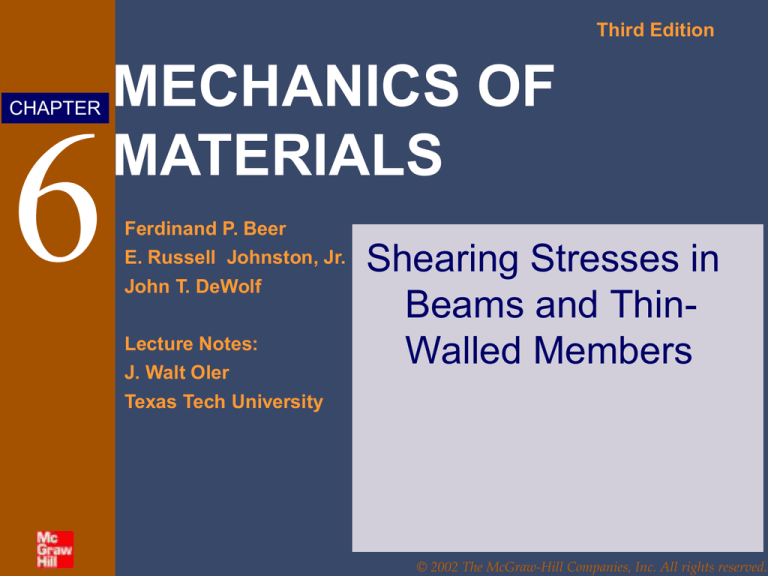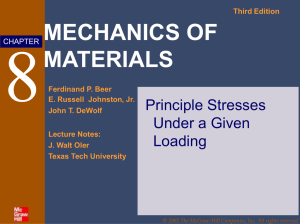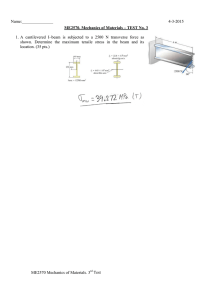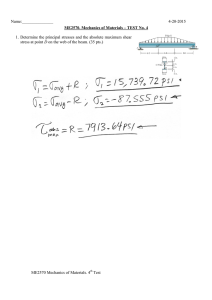
Third Edition
CHAPTER
6
MECHANICS OF
MATERIALS
Ferdinand P. Beer
E. Russell Johnston, Jr.
John T. DeWolf
Lecture Notes:
J. Walt Oler
Texas Tech University
Shearing Stresses in
Beams and ThinWalled Members
© 2002 The McGraw-Hill Companies, Inc. All rights reserved.
Third
Edition
MECHANICS OF MATERIALS
Beer • Johnston • DeWolf
Shearing Stresses in Beams and
Thin-Walled Members
Introduction
Shear on the Horizontal Face of a Beam Element
Example 6.01
Determination of the Shearing Stress in a Beam
Shearing Stresses txy in Common Types of Beams
Further Discussion of the Distribution of Stresses in a ...
Sample Problem 6.2
Longitudinal Shear on a Beam Element of Arbitrary Shape
Example 6.04
Shearing Stresses in Thin-Walled Members
Plastic Deformations
Sample Problem 6.3
Unsymmetric Loading of Thin-Walled Members
Example 6.05
Example 6.06
© 2002 The McGraw-Hill Companies, Inc. All rights reserved.
6-2
Third
Edition
MECHANICS OF MATERIALS
Beer • Johnston • DeWolf
Introduction
• Transverse loading applied to a beam
results in normal and shearing stresses in
transverse sections.
• Distribution of normal and shearing
stresses satisfies
Fx x dA 0
Fy t xy dA V
Fz t xz dA 0
M x y t xz z t xy dA 0
M y z x dA 0
M z y x 0
• When shearing stresses are exerted on the
vertical faces of an element, equal stresses
must be exerted on the horizontal faces
• Longitudinal shearing stresses must exist
in any member subjected to transverse
loading.
© 2002 The McGraw-Hill Companies, Inc. All rights reserved.
6-3
Third
Edition
MECHANICS OF MATERIALS
Beer • Johnston • DeWolf
Shear on the Horizontal Face of a Beam Element
• Consider prismatic beam
• For equilibrium of beam element
Fx 0 H D D dA
A
H
M D MC
y dA
I
A
• Note,
Q y dA
A
M D MC
dM
x V x
dx
• Substituting,
VQ
x
I
H VQ
q
shear flow
x
I
H
© 2002 The McGraw-Hill Companies, Inc. All rights reserved.
6-4
Third
Edition
MECHANICS OF MATERIALS
Beer • Johnston • DeWolf
Shear on the Horizontal Face of a Beam Element
• Shear flow,
q
H VQ
shear flow
x
I
• where
Q y dA
A
first moment of area above y1
I
2
y dA
A A'
second moment of full cross section
• Same result found for lower area
H VQ
q
x
I
Q Q 0
q
first moment with respect
to neutral axis
H H
© 2002 The McGraw-Hill Companies, Inc. All rights reserved.
6-5
Third
Edition
MECHANICS OF MATERIALS
Beer • Johnston • DeWolf
Example 6.01
SOLUTION:
• Determine the horizontal force per
unit length or shear flow q on the
lower surface of the upper plank.
• Calculate the corresponding shear
force in each nail.
A beam is made of three planks,
nailed together. Knowing that the
spacing between nails is 25 mm and
that the vertical shear in the beam is
V = 500 N, determine the shear force
in each nail.
© 2002 The McGraw-Hill Companies, Inc. All rights reserved.
6-6
Third
Edition
MECHANICS OF MATERIALS
Beer • Johnston • DeWolf
Example 6.01
SOLUTION:
• Determine the horizontal force per
unit length or shear flow q on the
lower surface of the upper plank.
VQ (500 N)(120 106 m3 )
q
I
16.20 10-6 m 4
3704 N
m
Q Ay
0.020 m 0.100 m 0.060 m
120 106 m3
I
1 0.020 m 0.100 m 3
12
1 0.100 m 0.020 m 3
2[12
• Calculate the corresponding shear
force in each nail for a nail spacing of
25 mm.
0.020 m 0.100 m 0.060 m 2 ]
16.20 10
6
m
4
© 2002 The McGraw-Hill Companies, Inc. All rights reserved.
F (0.025 m)q (0.025 m)(3704 N m
F 92.6 N
6-7
Third
Edition
MECHANICS OF MATERIALS
Beer • Johnston • DeWolf
Determination of the Shearing Stress in a Beam
• The average shearing stress on the horizontal
face of the element is obtained by dividing the
shearing force on the element by the area of
the face.
t ave
H q x VQ x
A A
I t x
VQ
It
• On the upper and lower surfaces of the beam,
tyx= 0. It follows that txy= 0 on the upper and
lower edges of the transverse sections.
• If the width of the beam is comparable or large
relative to its depth, the shearing stresses at D1
and D2 are significantly higher than at D.
© 2002 The McGraw-Hill Companies, Inc. All rights reserved.
6-8
Third
Edition
MECHANICS OF MATERIALS
Beer • Johnston • DeWolf
Shearing Stresses txy in Common Types of Beams
• For a narrow rectangular beam,
VQ 3 V
t xy
1
Ib 2 A
t max
y 2
c 2
3V
2A
• For American Standard (S-beam)
and wide-flange (W-beam) beams
VQ
It
V
t max
Aweb
t ave
© 2002 The McGraw-Hill Companies, Inc. All rights reserved.
6-9
Third
Edition
MECHANICS OF MATERIALS
Beer • Johnston • DeWolf
Further Discussion of the Distribution of
Stresses in a Narrow Rectangular Beam
• Consider a narrow rectangular cantilever beam
subjected to load P at its free end:
3 P
y 2
t xy
1 2
2 A c
x
Pxy
I
• Shearing stresses are independent of the distance
from the point of application of the load.
• Normal strains and normal stresses are unaffected by
the shearing stresses.
• From Saint-Venant’s principle, effects of the load
application mode are negligible except in immediate
vicinity of load application points.
• Stress/strain deviations for distributed loads are
negligible for typical beam sections of interest.
© 2002 The McGraw-Hill Companies, Inc. All rights reserved.
6 - 10
Third
Edition
MECHANICS OF MATERIALS
Beer • Johnston • DeWolf
Sample Problem 6.2
SOLUTION:
• Develop shear and bending moment
diagrams. Identify the maximums.
• Determine the beam depth based on
allowable normal stress.
A timber beam is to support the three
concentrated loads shown. Knowing
that for the grade of timber used,
all 1800 psi
t all 120 psi
• Determine the beam depth based on
allowable shear stress.
• Required beam depth is equal to the
larger of the two depths found.
determine the minimum required depth
d of the beam.
© 2002 The McGraw-Hill Companies, Inc. All rights reserved.
6 - 11
Third
Edition
MECHANICS OF MATERIALS
Beer • Johnston • DeWolf
Sample Problem 6.2
SOLUTION:
Develop shear and bending moment
diagrams. Identify the maximums.
Vmax 3 kips
M max 7.5 kip ft 90 kip in
© 2002 The McGraw-Hill Companies, Inc. All rights reserved.
6 - 12
Third
Edition
MECHANICS OF MATERIALS
Beer • Johnston • DeWolf
Sample Problem 6.2
• Determine the beam depth based on allowable
normal stress.
all
M max
S
1800 psi
90 103 lb in.
0.5833 in. d 2
d 9.26 in.
1 bd3
I 12
I
S 16 b d 2
c
16 3.5 in. d 2
0.5833 in. d 2
• Determine the beam depth based on allowable
shear stress.
3 Vmax
2 A
3 3000 lb
120 psi
2 3.5in. d
t all
d 10.71in.
• Required beam depth is equal to the larger of the two.
d 10.71in.
© 2002 The McGraw-Hill Companies, Inc. All rights reserved.
6 - 13
Third
Edition
MECHANICS OF MATERIALS
Beer • Johnston • DeWolf
Longitudinal Shear on a Beam Element
of Arbitrary Shape
• We have examined the distribution of
the vertical components txy on a
transverse section of a beam. We now
wish to consider the horizontal
components txz of the stresses.
• Consider prismatic beam with an
element defined by the curved surface
CDD’C’.
Fx 0 H D C dA
a
• Except for the differences in
integration areas, this is the same
result obtained before which led to
H
© 2002 The McGraw-Hill Companies, Inc. All rights reserved.
VQ
x
I
q
H VQ
x
I
6 - 14
Third
Edition
MECHANICS OF MATERIALS
Beer • Johnston • DeWolf
Example 6.04
SOLUTION:
• Determine the shear force per unit
length along each edge of the upper
plank.
• Based on the spacing between nails,
determine the shear force in each
nail.
A square box beam is constructed from
four planks as shown. Knowing that the
spacing between nails is 1.5 in. and the
beam is subjected to a vertical shear of
magnitude V = 600 lb, determine the
shearing force in each nail.
© 2002 The McGraw-Hill Companies, Inc. All rights reserved.
6 - 15
Third
Edition
MECHANICS OF MATERIALS
Beer • Johnston • DeWolf
Example 6.04
SOLUTION:
• Determine the shear force per unit
length along each edge of the upper
plank.
VQ 600 lb 4.22 in 3
lb
q
92
.
3
I
in
27.42 in 4
q
lb
46.15
2
in
edge force per unit length
f
For the upper plank,
Q Ay 0.75in. 3 in .1.875 in .
4.22 in 3
For the overall beam cross-section,
1 4.5 in 1 3 in
I 12
12
3
3
27.42 in 4
© 2002 The McGraw-Hill Companies, Inc. All rights reserved.
• Based on the spacing between nails,
determine the shear force in each
nail.
lb
F f 46.15 1.75 in
in
F 80.8 lb
6 - 16
Third
Edition
MECHANICS OF MATERIALS
Beer • Johnston • DeWolf
Shearing Stresses in Thin-Walled Members
• Consider a segment of a wide-flange
beam subjected to the vertical shear V.
• The longitudinal shear force on the
element is
H
VQ
x
I
• The corresponding shear stress is
t zx t xz
H VQ
t x It
• Previously found a similar expression
for the shearing stress in the web
t xy
VQ
It
• NOTE: t xy 0
t xz 0
© 2002 The McGraw-Hill Companies, Inc. All rights reserved.
in the flanges
in the web
6 - 17
Third
Edition
MECHANICS OF MATERIALS
Beer • Johnston • DeWolf
Shearing Stresses in Thin-Walled Members
• The variation of shear flow across the
section depends only on the variation of
the first moment.
q tt
VQ
I
• For a box beam, q grows smoothly from
zero at A to a maximum at C and C’ and
then decreases back to zero at E.
• The sense of q in the horizontal portions
of the section may be deduced from the
sense in the vertical portions or the
sense of the shear V.
© 2002 The McGraw-Hill Companies, Inc. All rights reserved.
6 - 18
Third
Edition
MECHANICS OF MATERIALS
Beer • Johnston • DeWolf
Shearing Stresses in Thin-Walled Members
• For a wide-flange beam, the shear flow
increases symmetrically from zero at A
and A’, reaches a maximum at C and the
decreases to zero at E and E’.
• The continuity of the variation in q and
the merging of q from section branches
suggests an analogy to fluid flow.
© 2002 The McGraw-Hill Companies, Inc. All rights reserved.
6 - 19
Third
Edition
MECHANICS OF MATERIALS
Beer • Johnston • DeWolf
Plastic Deformations
I
M
Y maximum elastic moment
• Recall: Y
c
• For M = PL < MY , the normal stress does
not exceed the yield stress anywhere along
the beam.
• For PL > MY , yield is initiated at B and B’.
For an elastoplastic material, the half-thickness
of the elastic core is found from
1 yY2
3
Px M Y 1 2
3c
2
• The section becomes fully plastic (yY = 0) at
the wall when
3
PL M Y M p
2
• Maximum load which the beam can support is
Pmax
© 2002 The McGraw-Hill Companies, Inc. All rights reserved.
Mp
L
6 - 20
Third
Edition
MECHANICS OF MATERIALS
Beer • Johnston • DeWolf
Plastic Deformations
• Preceding discussion was based on
normal stresses only
• Consider horizontal shear force on an
element within the plastic zone,
H C D dA Y Y dA 0
Therefore, the shear stress is zero in the
plastic zone.
• Shear load is carried by the elastic core,
3 P
t xy
1
2A
t max
y 2
where A 2byY
2
yY
3P
2 A
• As A’ decreases, tmax increases and
may exceed tY
© 2002 The McGraw-Hill Companies, Inc. All rights reserved.
6 - 21
Third
Edition
MECHANICS OF MATERIALS
Beer • Johnston • DeWolf
Sample Problem 6.3
SOLUTION:
• For the shaded area,
Q 4.31in 0.770 in 4.815 in
15.98 in 3
• The shear stress at a,
Knowing that the vertical shear is 50
kips in a W10x68 rolled-steel beam,
determine the horizontal shearing
stress in the top flange at the point a.
© 2002 The McGraw-Hill Companies, Inc. All rights reserved.
VQ 50 kips 15.98 in 3
t
It
394 in 4 0.770 in
t 2.63 ksi
6 - 22
Third
Edition
MECHANICS OF MATERIALS
Beer • Johnston • DeWolf
Unsymmetric Loading of Thin-Walled Members
• Beam loaded in a vertical plane
of symmetry deforms in the
symmetry plane without
twisting.
x
My
I
t ave
VQ
It
• Beam without a vertical plane
of symmetry bends and twists
under loading.
x
© 2002 The McGraw-Hill Companies, Inc. All rights reserved.
My
I
t ave
VQ
It
6 - 23
Third
Edition
MECHANICS OF MATERIALS
Beer • Johnston • DeWolf
Unsymmetric Loading of Thin-Walled Members
• If the shear load is applied such that the beam
does not twist, then the shear stress distribution
satisfies
D
B
E
VQ
t ave
V q ds F q ds q ds F
It
B
A
D
• F and F’ indicate a couple Fh and the need for
the application of a torque as well as the shear
load.
F h Ve
• When the force P is applied at a distance e to the
left of the web centerline, the member bends in a
vertical plane without twisting.
© 2002 The McGraw-Hill Companies, Inc. All rights reserved.
6 - 24
Third
Edition
MECHANICS OF MATERIALS
Beer • Johnston • DeWolf
Example 6.05
• Determine the location for the shear center of the
channel section with b = 4 in., h = 6 in., and t = 0.15 in.
e
Fh
I
• where
b
b VQ
Vb h
F q ds
ds st ds
I0 2
0
0 I
Vthb 2
4I
2
1 3
1 3
h
I I web 2 I flange th 2 bt bt
12
2
12
1 th 2 6b h
12
• Combining,
e
b
h
2
3b
4 in.
6 in .
2
34 in .
© 2002 The McGraw-Hill Companies, Inc. All rights reserved.
e 1.6 in .
6 - 25
Third
Edition
MECHANICS OF MATERIALS
Beer • Johnston • DeWolf
Example 6.06
• Determine the shear stress distribution for
V = 2.5 kips.
t
q VQ
t
It
• Shearing stresses in the flanges,
VQ V
h Vh
st
s
It
It
2 2I
Vhb
6Vb
tB
2 1 th 2 6b h th6b h
t
12
62.5 kips 4 in
2.22 ksi
0.15 in 6 in 6 4 in 6 in
• Shearing stress in the web,
1
VQ V 8 ht 4b h 3V 4b h
t max
2
1
It
th 6b h t 2th6b h
12
© 2002 The McGraw-Hill Companies, Inc. All rights reserved.
32.5 kips 4 4 in 6 in
3.06 ksi
20.15 in 6 in 6 6 in 6 in
6 - 26





